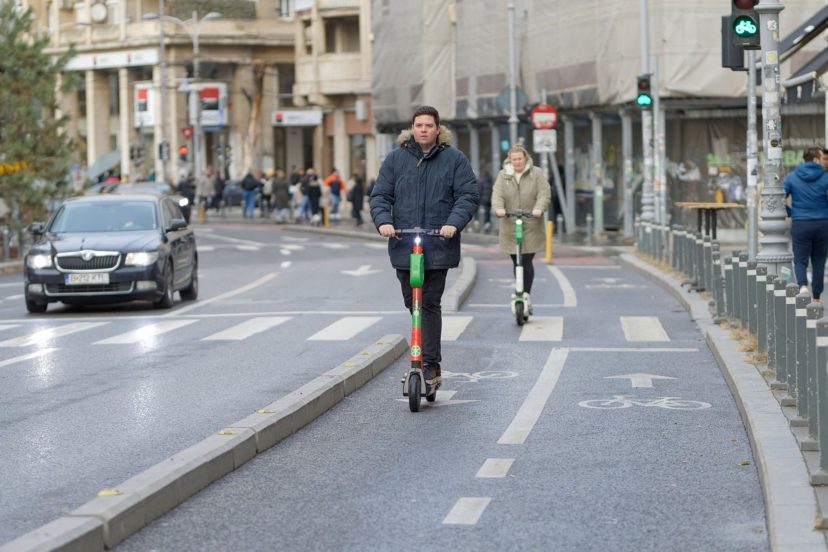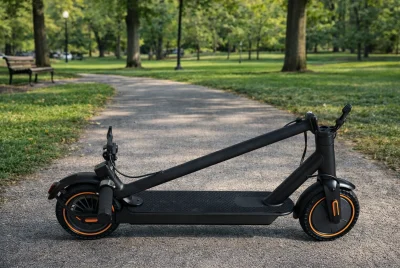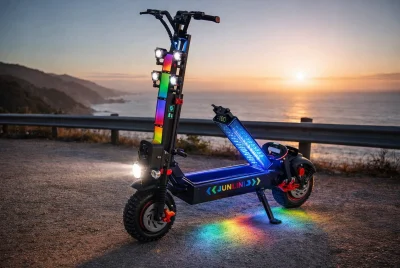Electric Scooter Weight Guide: Tips for Optimal Performance
*We may earn a commission for purchases made using our links. Please see our disclosure to learn more.
Are you ready to zip through the city on an electric scooter but worried about how much weight it can handle? You’re not alone. Many riders wonder whether their e-scooter is up to the task of carrying them comfortably and safely while still delivering top-notch performance.
Did you know that most electric scooters are designed with a specific weight limit in mind, generally between 220 and 265 pounds? That’s right – your scooter isn’t just a one-size-fits-all ride!
In this guide, we’ll dive deep into everything you need to know about electric scooter weight limits and provide practical tips for maintaining optimal performance, even if you’re on the heavier side.
From understanding why the weight matters to learning how to distribute your load for better balance, our advice will keep you gliding smoothly down the street. Stick around; this could be the key to unlocking your best ride yet!
Understanding Electric Scooter Weight Limit
Electric scooter weight limit is the maximum load capacity that the scooter can safely handle. It is crucial for safety, performance, and durability of the scooter. Factors affecting weight limit include frame materials, motor power, battery capacity, suspension, and tires.
Definition and measurement
The weight limit of an electric scooter refers to the maximum weight it can safely carry while operating. This figure includes the rider and any additional items like a backpack or groceries.
Manufacturers determine this number through rigorous testing considering factors such as frame strength, motor capacity, and battery life. Generally, most scooters on the market support between 220 and 265 pounds, ensuring they cater to a wide range of users.
To measure an electric scooter’s weight capacity accurately, look at its specifications listed by the manufacturer. Heavy-duty models tend to have higher limits for heavier riders; these are constructed with stronger materials to handle increased stress without compromising performance or safety.
Knowing your own weight is crucial when selecting a scooter that fits within these parameters—choosing one that supports your weight plus any extra cargo will help maintain optimal functionality and longevity of the device.
Importance for safety, performance, and durability
Understanding the weight limit of an electric scooter is vital for ensuring safety, optimal performance, and long-term durability. Exceeding the weight capacity can lead to compromised stability and control, increasing the risk of accidents and injuries.
Additionally, operating an electric scooter beyond its weight limit may result in excessive strain on the motor, battery, and frame components, potentially leading to premature wear and tear.
It’s crucial to adhere to the specified weight limit to maintain safety standards while maximizing the scooter’s performance and lifespan.
For heavier riders or individuals approaching the upper weight limit of a specific electric scooter model, understanding and respecting the weight capacity is essential for a smooth riding experience.
By choosing an electric scooter that aligns with one’s bodyweight within its designated limits, riders can enjoy improved maneuverability, extended battery life efficiency, reduced mechanical stress on essential components such as motor and suspension system – ultimately contributing to enhanced overall ride quality.
Factors Affecting Electric Scooter Weight Limit
The weight limit of an electric scooter is affected by several factors including the frame and construction materials, motor power and torque, battery capacity, suspension, and tires.
Each of these elements plays a key role in determining the maximum weight capacity of the scooter.
Frame and construction materials
Electric scooters come in a variety of frame and construction materials, including aluminum, steel, carbon fiber, and titanium. These materials can significantly impact the overall weight of the scooter as well as its durability and performance.
Aluminum frames are lightweight and corrosion-resistant, making them a popular choice for electric scooters intended for commuting or recreational use. Steel frames provide robustness and stability but often result in heavier scooters.
Carbon fiber is exceptionally lightweight and offers high strength, contributing to enhanced agility and speed. Titanium frames combine strength with light weight; however, they are less common due to their higher cost.
Manufacturers carefully select these materials to achieve an optimal balance between sturdiness, weight capacity, maneuverability, and cost-effectiveness when designing electric scooters.
Motor power and torque
Electric scooters with higher motor power and torque can handle heavier loads more efficiently, allowing for smoother acceleration and better overall performance. The motor’s power directly impacts the scooter’s ability to carry additional weight without sacrificing speed or range.
Higher torque enables the scooter to navigate inclines and uneven terrain with ease, providing a more comfortable ride regardless of the rider’s weight.
When selecting an electric scooter for heavy riders, it is crucial to consider the motor’s power and torque capabilities in relation to the rider’s weight. Models with robust motors are better equipped to accommodate heavier individuals while maintaining optimal performance.
Additionally, higher torque contributes to improved responsiveness and control, making it easier for riders to maneuver their scooters safely and confidently.
Investing in an electric scooter with sufficient motor power and torque ensures that heavier riders can enjoy a smooth, efficient ride without compromising on performance or safety.
Battery capacity
Most electric scooters are equipped with rechargeable lithium-ion batteries. These batteries have varying capacities, measured in watt-hours (Wh), and determine the scooter’s range and power output.
Higher battery capacity generally results in a longer riding range, making it essential to consider when selecting an electric scooter for heavier riders or commuting long distances.
Battery capacity directly impacts the performance and endurance of the scooter, ensuring adequate power supply for a smooth ride across different terrains.
Lithium-ion batteries used in electric scooters typically come in various capacities ranging from 250Wh to 1000Wh or more, providing options for riders with different needs and usage patterns.
A higher-capacity battery can support heavier loads better while maintaining optimal performance levels. When selecting an electric scooter, paying attention to the battery capacity is crucial as it plays a vital role in supporting heavier riders and ensuring sufficient power reserves for extended rides.
Suspension and tires
Understanding the impact of suspension and tires on an electric scooter’s weight limit is crucial. The quality of suspension directly affects the scooter’s ability to handle heavier loads, absorbing shock and providing stability.
Similarly, the tires play a vital role in carrying the weight of the rider while maintaining traction and ensuring a smooth ride. Choosing an electric scooter with sturdy and durable suspension components, as well as high-quality tires, can significantly enhance its performance when carrying heavier riders or loads.
Properly maintained suspension systems and well-inflated tires contribute to an electric scooter’s overall weight capacity and safety. Quality suspensions designed for varying loads can help distribute weight evenly across the scooter, reducing strain on individual components.
Tips for Optimal Performance
Distribute weight evenly on your electric scooter for better performance and stability, and don’t forget to regularly maintain and inspect your scooter. Interested in learning more about how to optimize the performance of your electric scooter? Keep reading!
Proper weight distribution
To ensure optimal performance and safety of your electric scooter, it is crucial to distribute your weight evenly. Uneven distribution can affect the balance and handling of the scooter, potentially leading to accidents or damage to the vehicle.
By placing your weight in the center of the scooter and maintaining a balanced stance, you can enhance stability and maneuverability, especially when navigating turns or uneven terrain.
Additionally, distributing your weight properly over the scooter’s frame helps prevent unnecessary strain on specific components, contributing to its longevity and durability.
Furthermore, proper weight distribution plays a significant role in maximizing battery life and motor efficiency. When positioned centrally over the wheels, particularly during acceleration or braking, you help maintain an equilibrium that minimizes unnecessary stress on the scooter’s propulsion system; this results in improved energy conservation and extended ride times between charges.
Regular maintenance and inspections
Regular maintenance and inspections are crucial for optimizing electric scooter performance and ensuring rider safety. Here are some key aspects to consider:
- Regularly inspect the tires for wear and tear, and ensure they are properly inflated according to the manufacturer’s recommendations.
- Keep the battery charged within the specified voltage range, and check for any signs of corrosion on the terminals.
- Clean the scooter regularly to prevent dirt buildup that can affect its performance and longevity.
- Check all bolts, screws, and connections regularly to ensure they are secure and in good condition.
- Look for any signs of damage or unusual noises during operation, and address them promptly to prevent further issues.
- Lubricate moving parts such as hinges, folding mechanisms, and brake cables to maintain smooth operation.
- Follow the manufacturer’s recommended maintenance schedule for components such as brakes, suspension, and motor to keep them in optimal condition.
Riding techniques and precautions
When riding an electric scooter, it is important to follow proper techniques and take necessary precautions to ensure safety and optimize performance:
- Maintain a stable center of gravity by keeping your body upright and centered over the scooter.
- Bend your knees slightly to absorb shocks and maintain stability on uneven surfaces.
- Keep a firm grip on the handlebars and avoid sudden movements or jerky steering.
- Always look ahead and anticipate potential obstacles or hazards in your path.
- Obey traffic rules and signals, and always yield to pedestrians.
- Use hand signals when turning or changing lanes to communicate your intentions to other road users.
- Stay alert and avoid distractions such as using a phone while riding.
- Be mindful of weather conditions, especially wet or slippery surfaces, which may affect traction.
Consequences of Exceeding Weight Limit
Exceeding the weight limit of an electric scooter can pose safety risks, potentially damage the scooter, and even void warranty and insurance coverage. It’s important to understand the potential consequences of overloading your electric scooter to ensure a safe and enjoyable riding experience.
Safety risks
Exceeding the weight limit of an electric scooter can pose serious safety risks for riders. It may lead to loss of control, reduced maneuverability, and increased stopping distances, especially in emergency situations.
Additionally, overloading the scooter can strain its components and compromise its structural integrity, potentially leading to malfunctions or failures while riding. This not only endangers the rider but also poses a hazard to other pedestrians and road users.
Furthermore, pushing an electric scooter beyond its weight capacity can result in accelerated wear and tear on essential parts such as the motor, battery, brakes, and tires. This can lead to premature mechanical issues that may compromise the overall performance and reliability of the scooter.
Potential damage to the scooter
Exceeding the weight limit of an electric scooter can lead to potential damage to the vehicle. The excess strain on the motor, battery, and frame can result in premature wear and tear.
Additionally, overloading an electric scooter may cause decreased stability and control, leading to increased risk of accidents. The added stress from excess weight could also impact the suspension system and tires, potentially affecting ride quality and safety.
Damaging effects on an electric scooter due to exceeding weight limits may void manufacturer warranty coverage as well as insurance protection. Repairs for damages caused by overloading are typically not covered by warranties or insurances, leaving riders with costly out-of-pocket expenses.
It is crucial for riders to adhere to recommended weight limits for their specific electric scooter model in order to prevent potential harm both to themselves and their vehicles.
Voiding warranty and insurance coverage
Potential damage to the scooter could lead to voiding warranty and insurance coverage. Exceeding the recommended weight limit or overloading an electric scooter is likely to cause wear and tear on its components, which could result in damages not covered by warranty or insurance.
It’s essential to understand the weight capacity of your electric scooter and adhere to it, as exceeding this limit can have costly consequences. Regularly inspecting the scooter for any signs of strain due to excessive weight is crucial in preventing potential issues that may impact warranty and insurance coverage.
Conclusion
In summary, understanding the weight limit of your electric scooter is crucial for a safe and smooth ride. Proper weight distribution, regular maintenance, and riding techniques are key to optimal performance.
Exceeding the weight limit can pose safety risks and potentially damage the scooter. It’s essential to consider these tips when selecting an electric scooter for your needs.
FAQs
1. What is the weight limit for adults on electric scooters?
Electric scooter weight limits for adults vary, but it’s important to choose one that supports your weight for safety and optimal performance.
2. How does weight distribution affect an electric scooter?
Proper weight distribution on an electric scooter helps maintain stability and extends the life of the scooter by preventing overloading.
3. Can heavy riders find suitable electric scooters?
Yes, there are heavy-duty electric scooters designed specifically for heavier riders with higher weight capacities for commuting or leisure.
4. Are there special tips for overweight individuals using electric scooters?
Overweight individuals should look for recommended weight limits on electric scooters and follow safety tips like distributing their weight evenly while riding.
5. How do I manage my electric scooter’s load to keep its best performance?
Manage your load by following guidelines on appropriate loading, avoid overloading your scooter, ensure even distribution of any additional weights, and always check the manufacturer’s guidelines regarding maximum carrying capacity before embarking on a ride.




